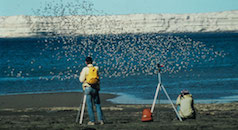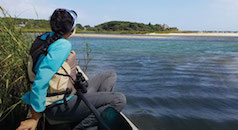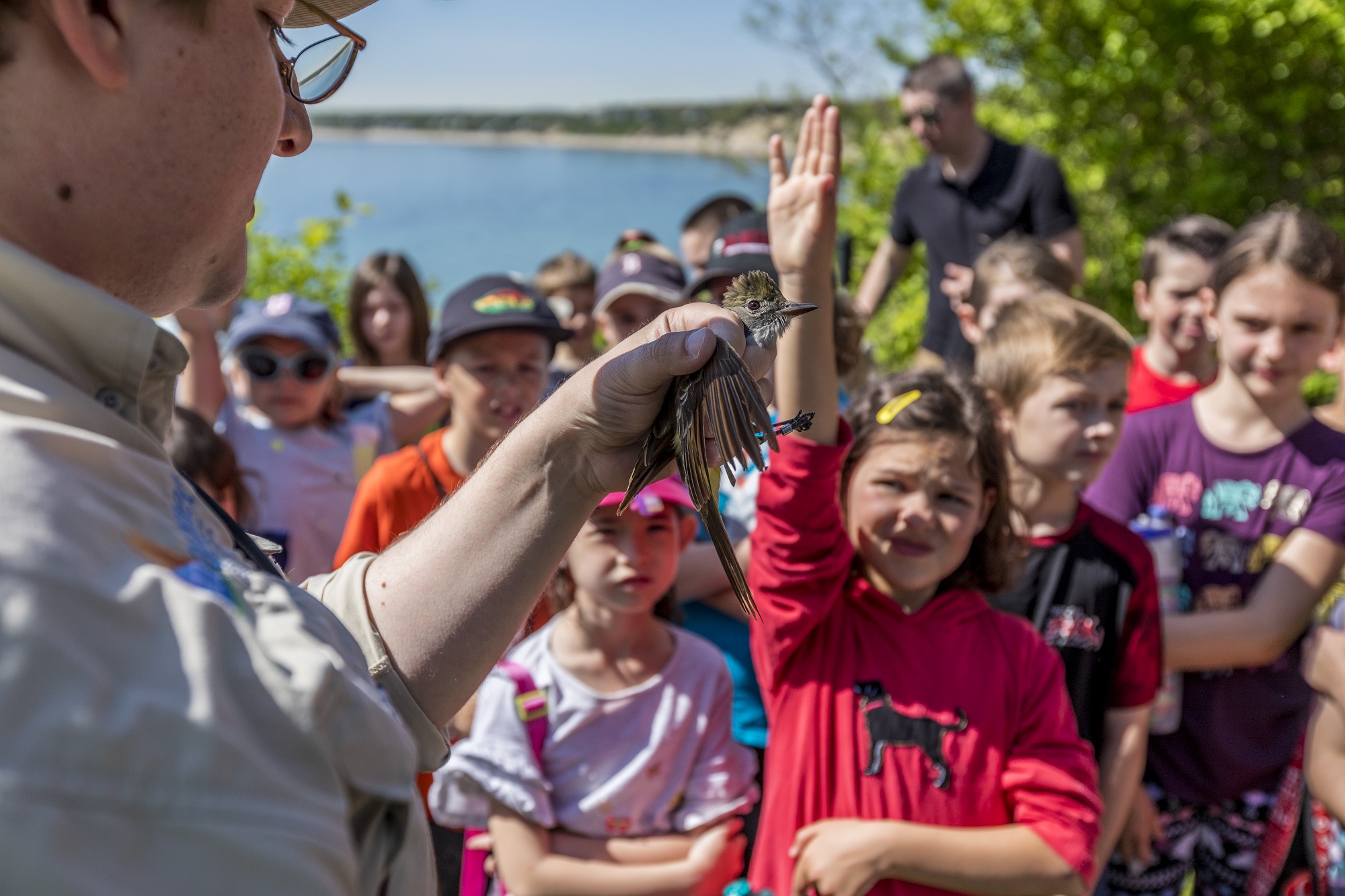Search Results

Manomet Works With Mexican Scientists to Monitor Laguna Madre Shorebirds
Manomet scientists visited Texas last month to work with biologists from the Mexican state of Tamaulipas and establish International Shorebird Survey (ISS) monitoring sites in the Laguna Madre of Mexico, one of the most important wetland systems in the Western Hemisphere. Shorebird Biologist Brad Winn and Senior Scientist Emeritus Brian Harrington led the monitoring section of the workshop with more than 20 participants from Mexico and the United States. The entire Laguna Madre complex, on both sides of the border, stretches for almost 400 miles. The area is ecologically rich, supporting millions of wintering waterbirds, including hundreds of thousands of shorebirds. A contingent of scientists had traveled from Mexico and the workshop laid the groundwork for long-term shorebird...
Manomet Releases Climate Change and Biodiversity in Maine Report
More than a third of the Maine species assessed in a newly released Manomet report were determined to have high vulnerability to climate change. The report, Climate Change and Biodiversity in Maine, defined high vulnerability as species that will experience at least a 66 percent population decline as a result of climate change by 2100. Researchers looked at 442 species in Maine and found 168 were highly vulnerable. Another 38 percent, or 171 species, fell into the medium range of vulnerability. The report was a collaborative effort, with scientists from the Maine Natural Areas Program, Maine Dept of Inland Fisheries and Wildlife, The Nature Conservancy, Maine Audubon and U.S. Fish and Wildlife Service running a statistical analysis...
Fish and Wildlife Service Proposes Rufa Red Knot for Threatened Listing
Last week, the U.S. Fish & Wildlife Service (USFWS) released a proposal to list the rufa Red Knot as threatened under the Endangered Species Act. This long-awaited proposal is being celebrated in the conservation community after decades of research on this declining shorebird species. Red Knot populations in some areas have decreased by about 75 percent since the 1980s, with the steepest declines occurring after 2000. Manomet has been working with regional, national and international partners to assess threats to rufa Red Knot populations, collect and publish data and outline metrics for recovery. “The Red Knot has been a focal species of Manomet’s shorebird research since the 1980s, when Manomet Biologist Brian Harrington first brought its migration...
SRP Director Charles Duncan To Be Succeeded by Stephen Brown
At the beginning of November, longtime Shorebird Recovery Project Director Charles Duncan will step down and will be succeeded by Director of Shorebird Science Stephen Brown. Duncan has led the SRP for a decade and said that he wants to step back and “reconfigure” his career. Manomet President John Hagan praised Duncan’s work, especially in extending the geographic reach of the program and collaborating with local partners. “As director of the Executive Office of the Western Hemisphere Shorebird Reserve Network, he helped add 32 new sites, more than 7.5 million acres,” Hagan said. “WHSRN has become a global model of how to engage people on a voluntary basis to do big things. All of that is a...
Walberg Presents Climate Change Adaptation Strategies
As landowners grapple with the daunting complexity of climate change adaptation, infrastructure issues – such as access roads and water crossings – provide a direct intersection between climate change impacts and private land management decisions. This was one of the lessons that Manomet Senior Program Leader Eric Walberg shared with the Gulf of Maine Council’s Climate Network during a conference earlier this month. Walberg talked about lessons learned from Manomet’s climate change adaptation planning at the Allen Whitney Memorial Forest in Maine and at Tidmarsh Farms in Massachusetts. The conference featured speakers from the U.S. Fish and Wildlife Service, the U.S. Forest Service, the National Oceanic and Atmospheric Administration and many other organizations. Walberg also told...
Biddeford-Saco-OOB Courier: Green crabs a sign the tide is turning
This article was originally published in The Biddeford-Saco-OOB Courier (Maine) on September 5, 2013. It was written by Ben Meiklejohn. View the original article here. SCARBOROUGH, MAINE – About 50 people attended a public presentation sponsored by the Scarborough Conservation Commission Aug. 28 to learn about the possible impact of a global rise in sea level on the Scarborough Marsh. Marine geologist Pete Slovinsky of the Maine Department of Agriculture, Conservation and Forestry presented projection scenarios for rises in sea level from one to 6.5 feet over the next century. Scarborough is also part of the Sea Level Adaptation Working Group, which has worked since 2009 on sea level and storm issues in Saco Bay communities, including Saco, Biddeford and...
keepMEcurrent.com: Planners ‘test the waters’ on Scarborough Marsh migration
This article was originally published on keepMEcurrent.com on September 4, 2013. It was written by Duke Harrington. View the original article here. SCARBOROUGH, MAINE – Steve Stracqualursi doesn’t need a government-funded study to tell him things are changing in the waters around Scarborough. “I catch more crabs than fish now. They grab right on to the line,” he said last week at a Town Hall forum held to discuss the impacts of sea level rise. Stracqualursi, one of about 60 residents to attend the session, was referring to the growing numbers of European green crab, which can take over native clam flats. But this summer also has seen an explosion in Asian shore crab, which burrow into sandy areas, killing marsh...
Maine Waters Particularly Vulnerable to Climate Change, Report Says
Researchers believe that climate change will cause 44 percent of Maine’s landscape to change to a different kind of habitat over the next hundred years, the highest percentage of any state. A new report – available online today – provides sharper detail on which habitats will be heavily impacted by climate change and what stressors they will face. “Climate Change and Biodiversity in Maine: A Climate Change Exposure Summary for Species and Key Habitats” was a collaboration between Manomet, The Nature Conservancy, the Maine Department of Inland Fisheries and Wildlife, Maine Audubon Society, the Maine Natural Areas Program and the U.S. Fish and Wildlife Service. “We produced this report to create a baseline of information for wildlife biologists...
Scientific Expedition in Mexico Discovers Shorebird Wintering Site
A Manomet-led expedition earlier this year in Oaxaca, Mexico, discovered a previously unknown wintering site for Red Knots. The expedition took place in February and was led by Dr. Eduardo Palacios, program coordinator for Northwest Mexico with Manomet’s Shorebird Recovery Project. The team discovered about 200 Red Knots (Calidris canutus) at Laguna Superior in Oaxaca. "The key and inescapable new finding of this research is that there is a population segment of Red Knots wintering in Oaxaca that connects to Texas during northbound migration on the way to the breeding grounds," Palacios said. In February 2012, birdwatchers in Oaxaca reported seeing three Red Knots that had been banded in Texas. The observers also reported frequently seeing as...
Building a Future for Fishing in Downeast Maine
The communities of coastal Maine depend on fishing, but the industry has been in trouble since stocks of groundfish species like cod, haddock and flounder collapsed over 20 years ago. Prey species like herring and alewives are also in serious decline, Atlantic salmon are listed as endangered and shad and smelt are listed as species of concern. The fishery is far less diverse than it once was and the coastal economy is primarily dependent on the lobster fishery. Manomet has partnered with two Maine nonprofits, the Downeast Salmon Federation and the Penobscot East Resource Center, to form the Downeast Fisheries Partnership, a regional effort to restore productive and diverse fisheries in Downeast Maine. On July 30th, Manomet held an...



